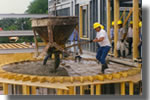
1. A bad concrete job is almost always the result of poor preparation, placing, finishing and/or curing practices. Very seldom is the concrete itself of poor quality. There are only a few variables in making ready mix concrete. The odds are that the failure occurred because of one or more of the many variables in preparation, placing, finishing, and/or curing.
2. Concrete test cylinders do not measure the strength of in-place concrete. Test cylinders are very useful for evaluating concrete mix designs, but they do not replicate the conditions of in-place concrete. In order to have a valid comparison of test results the samples must be taken and cured in a consistent manner with a limited range of variables. Concrete in-place is subject to many different environmental conditions that are not usually the same as the test cylinders and those conditions will usually result in lower strength of in-place concrete. That is why cores taken from in-place concrete only need to meet 85% of the specified strength.
3. Liquid admixtures are a fairly insignificant addition to the cost of a cubic yard of concrete. High quality admixtures make concrete stronger, more durable, and improve finishability. The cost difference between using a low quality admixture and a high quality admixture is slight, so always use a ready mix company that uses high quality admixtures.
4. If you don’t use a membrane curing compound on your concrete job you are throwing away a sack of cement in the mix. I really don’t know the exact amount of cement you are wasting, but it is significant. Always use a curing method on your concrete. A membrane curing compound is the cheapest and easiest way to make your concrete more durable, less permeable, and stronger. If you can’t use a membrane curing compound, use one of the other methods like sheets or moist blankets. Those methods are more difficult to use and maintain than a sprayed on membrane curing compound, but are better than not curing at all.

5. Some tips on how to sound knowledgeable when talking about concrete: